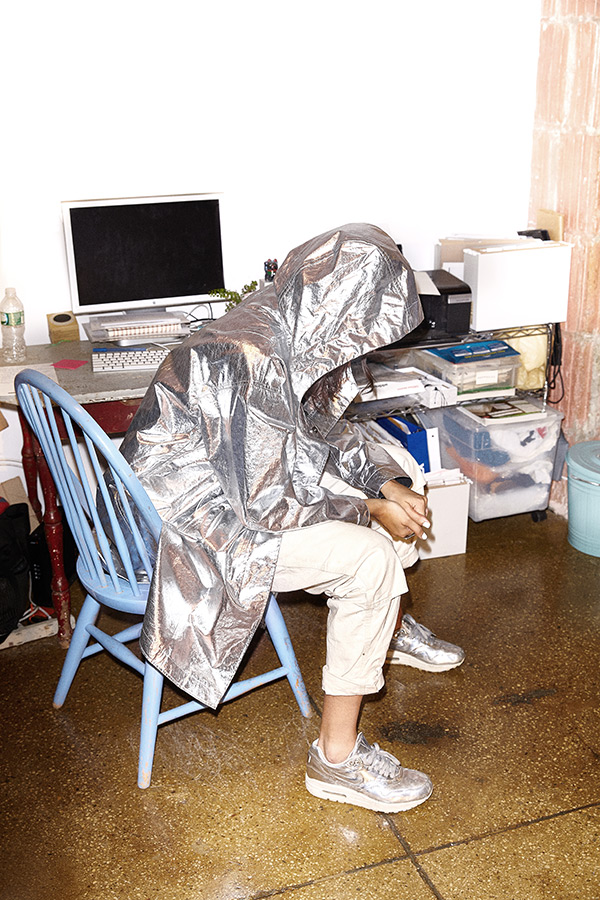Office – I love the fleece jacket, I feel like it’s almost a fashion crossover for people who are into the whole hip-hop look. Like a high-style North Face.
Yara Flinn – I’m a hundred percent inspired by outerwear, especially the North Face. High school is one of my biggest sources of inspiration. I went to high school in Chelsea, on 17th St., and when I was growing up, everyone wore khakis and North Face jackets.
O – Sounds like I went to a very similar high school.
YF – Same vibe, right? Like, preppy thugs. What color North Face did you have?
O – I think I had the blue…
YF – I had tumbleweed, remember the sage green one? That was like the new color, I was so psyched.
O – Absolutely, that was the one the crunchy kids had, who were like, hiking in them. Nobody was comfortable dressing like an actual thug at my high school, because it was like “Dude, we know where you live. Give me a break.”
YF – The yellow ones were for the ballers. Red and yellow, you were like, that’s a cool kid. I remember it was really hard to convince my parents to buy that jacket for me, they were like “What? This is ridiculous.” I was like, “This is going to be my jacket forever, it’s got a lifetime warrantee!” That definitely lasted a while. Then I was really into Triple Five Soul, I was kind of like, into the conscious hip-hop thing.
O – That was big for a while, especially in San Francisco. Conscious hip-hop, spoken word, poetry slams…[Laughs]
YF – Yeah, I went to Nuyorican [Poet’s Café] when I was in high school. I even wore headwraps sometimes. [Laughs] Oh god, that’s the darkest thing about me that’s ever come out!
O – [Laughs] I love it. It was a whole awkward phase for a lot of people.
YF – Aesop Rock came long before A$AP Rocky. Calling you out A$AP Rocky!
O – The first time I saw the name A$AP Rocky I was like “Wait, is Aesop Rock rebranding? Is he trying to be relevant again?”
YF – Yeah, did he get like, twenty years younger?
O – [Laughs] Right, and super into fashion?
YF – Being really into fashion was definitely not cool in our high school days.
O – True, but it felt like kids would try anything in the search for their identity. I can remember the hip-hop phase, then there was punk rock.
YF – That you really couldn’t pull off.
O – Yeah, it’s like, I’m supposed to dress like a junkie right now?
YF – I’m sure your parents loved that one. I think that’s so important though. When I see kids now that are so fashion-conscious and they’re like fourteen, I’m like “You’re supposed to look like an asshole at that age, you’re supposed to be wearing thrift store shit.” It’s too advanced. Those kids will get excited and be like “You’re a fashion designer!” and I’m like “Yeah, that’s lame though. I want to be a rapper, that’s so much cooler!”
O – Tell me about Nomia, what’s happening with the line?
YF – Well, I am shipping my first Resort collection to Barney’s, which has been my dream store forever. So that’s exciting. But then also I have my personal favorites, really obscure stores that I love, like Maryam Nassir Zadeh, Totokaelo, Creatures of Comfort, that mean a lot to me because of how small they are.
O – Because your brand has a greater presence in those smaller settings?
YF – Yeah exactly. But at the same time I think it’s really important to have a major like Barney’s to give your brand the validation that a lot of consumers need to believe in it. But I don’t really shop that much, to be honest. I feel kind of bad making clothes and not shopping. One day I’ll shop a lot though!
O – Where do you get your clothes then?
YF – These pants are Dickies, this is a Gang Gang Dance T-shirt.
O – You had to buy those shoes…
YF – I had to buy these shoes, I love these shoes. Specifically, I love silver shoes, I have four or five pairs. You know what’s really sad? Oh god, I don’t even want to say this. I want to say it, but not in a misogynistic way—girls really like shiny things!
O – [Laughs] There’s nothing wrong with that!
YF – I know but it feels kind of wrong to say it. We’re just
